As an Amazon Associate, I earn from qualifying purchases.
The best computer in the world is useless if you can’t see what you’re doing with it, and that’s doubly true for Photoshop editing. The best monitors will showcase your work in all its glory, but a bad monitor can waste your editing time and cause no end of headaches (both literally and figuratively), so it’s worth taking some time to make sure you’re using the best monitor for Photoshop editing.
My name is Thomas Boldt, and I’m one of the hardware experts here at PhotoshopBuzz. I think the first computer monitor I ever used was a green monochrome screen back in an 80s schoolroom, which might possibly have been before the release of Photoshop 1.0, but monitor technology has improved by several orders of magnitude since then.
My fascination with computer hardware never went away, and I’ve been carefully sourcing my own computer gear ever since PCs became affordable to the average home user, so I can help translate all the tech jargon into useful information.
In this article, I’ll break down the features that make a monitor perfect for Photoshop editing and explain why they matter. Then I’ll pick out a few different monitors that are suited to a range of different users and explain how each one meets a particular need so that you can choose the best monitor for your personal Photoshop editing needs.
Table of Contents
Key Takeaways
- Full coverage of the sRGB color gamut is the most important feature of a monitor
- For high-end print work, full coverage of the AdobeRGB colorspace is also essential
- Monitors with high pixel density provide the most detailed view of your images
- Choose a screen size that complements your chosen resolution and viewing distance.
- A range of display connectivity options gives you added flexibility when connecting multiple devices
How to Choose a Monitor for Photoshop Editing
A lot of high-end monitors are created for the gaming sector, which can make it difficult to determine which features matter most for Photoshop editing and which ones aren’t as important for creative pros. Let’s take a look at the tech specs that really matter, shall we?
Color Gamut
Since the main purpose of your monitor is to represent the colors in your Photoshop documents accurately, full 100% coverage of the standard sRGB color space used in digital graphics is the most important feature. If possible, it should also be able to display 100% of the Adobe RGB color space that’s used in some high-end photography workflows, although this isn’t absolutely essential for many Photoshop users.
Panel Type
Most monitors that are designed for creative professionals use IPS panel technology for its excellent brightness, color reproduction, and viewing angles, but newer models featuring OLED and mini-LED panels are starting to appear to challenge them. For the most part, these new panel types are still on the more expensive side of things, but they also produce much deeper blacks and better contrast ratios than IPS panels.
On the other hand, OLED panels can experience burn-in damage caused by leaving a screen displaying the same content for too long, which leaves a faint transparent impression of that content on the screen forever. Mini-LED displays don’t suffer from the burn-in problem, but they are also still quite rare and expensive at the moment.
If you want a full technical breakdown of the differences between panel types, you can check out this excellent guide from Ars Technica, but it’s heavy on the details, and it’s not on the required reading list.
Screen Size
The most popular monitor size for professional applications seems to be 27 inches at the moment, although the best size for you will depend at least partly on the amount of desk space you have to work with, and what you feel most comfortable with.
32-inch monitors are becoming a bit more popular, but I think you get diminishing returns when your screen gets any larger than that, partly because pixel density usually goes down and partly because of the ergonomic issues that you might experience if you’re sitting too close, looking from one side of the monitor to the other, repeatedly, all day.
Resolution
The quick and simple answer for the perfect Photoshop resolution is that it should be 4K / UHD (3840 x 2160), but it’s a bit more complicated than that because the ‘best’ resolution is partially dependent on the screen size you’ve selected and your budget.
At the same viewing distance, a 24-inch monitor with 2560 x 1440 resolution can look almost as good as a 32-inch monitor with 3840 x 2160 resolution because the pixel-per-inch (PPI) density is fairly similar (122 PPI vs. 137 PPI, respectively), but the smaller monitor is also going to be much more affordable.
Refresh Rate
The monitor market has been flooded recently by displays that feature extremely high refresh rates, but this doesn’t matter as much for Photoshop. Although gaming monitors can push their refresh rates as high as 240 Hz or even 360 Hz, all modern monitors can provide a minimum refresh rate of 60 Hz, which is more than enough for use with Photoshop.
If you’re doing a lot of work with a drawing tablet, you might see a slight benefit from a 120 Hz monitor, but it won’t make a difference for 99% of Photoshop users, and even dedicated digital artists might not notice.
Bonus Features
Once you’ve covered all the essential features of a good monitor, some additional bonus features can help you decide between similar models.
The very top tier of Photoshop editing monitors may have their own built-in calibration devices to ensure color accuracy, but otherwise, you’ll need to use a third-party calibration solution.
Monitor hoods can also be useful in color-sensitive workflows, allowing you to minimize screen glare and the impact of any ambient room light on your display.
Last but not least, many high-end monitors also have USB hubs that can be useful for connecting additional devices without making you strain to use a port on the back of your computer.
The Best Monitors for Photoshop Editing Reviewed
Now that you know what makes a good monitor for Photoshop editing, it’s time to look at a few models that are ideal for different scenarios. I’ve selected the best monitor for those of you who need absolutely perfect color accuracy all the time (and also have a high budget), along with the best 32” monitor, the best 27” monitor, and the best budget monitor so that you can choose the perfect one for your workspace and work style.
Best for Perfect Color Accuracy: Eizo ColorEdge CS2740
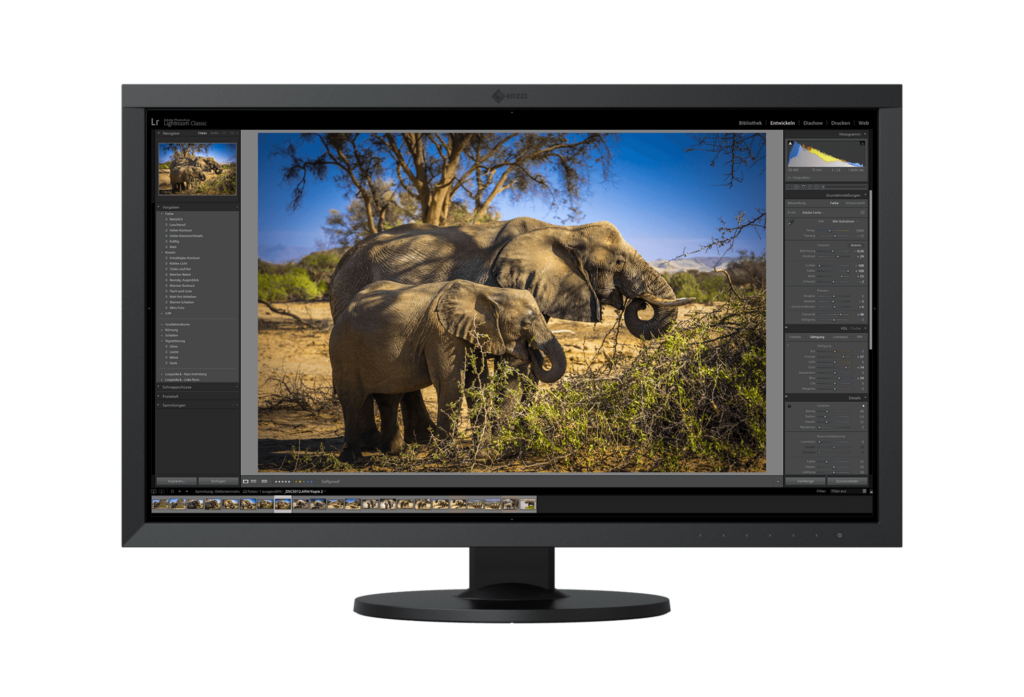
- Color Gamut: 100% sRGB, 100% AdobeRGB, 90% P3
- Panel Type: IPS
- Screen Size / Resolution: 27 inches / 3840 x 2160
- Connectivity: USB Type-C, DisplayPort, HDMI
- Bonus Features: USB hub
Eizo makes a full range of high-end professional monitors that can top $10,000, but that’s a bit excessive for almost everyone, so I don’t recommend them. Even this much more affordable model is still at the top end of the monitor price range, although there are very good reasons for it.
Eizo has a reputation as one of the most precise monitor manufacturers in the world, and the ColorEdge CS2740 lives up to that reputation. It covers 100% of the sRGB colorspace and the AdobeRGB colorspace, as well as virtually any other color space that you might need for a print-based Photoshop editing workflow.
While this monitor doesn’t come with Eizo’s traditional built-in hardware calibration device or monitor hood, it does offer a USB hub with two USB 3.1 Type-A ports and two USB 2.0 Type-A ports.
In addition to its USB hub, it can also accept USB Type-C for video input, which makes it a great secondary monitor for working with modern USB-C laptops like the MacBook Pro line. It also supports DisplayPort and HDMI to connect to any modern desktop machine.
No matter how good it is, though, the CS2740 is simply too expensive to provide an optimal price/performance balance for most Photoshop users, but if you need the absolute best in color accuracy for print work and you’ve got an unlimited budget, this monitor is a great entry into the world of high-end professional monitors.
The TLDR Summary: Eizo ColorEdge CS2740 is best for Photoshop users who focus on print work and anyone who needs color accuracy across multiple app workflows
Best 32” Monitor for Photoshop Editing: ASUS ProArt PA329C
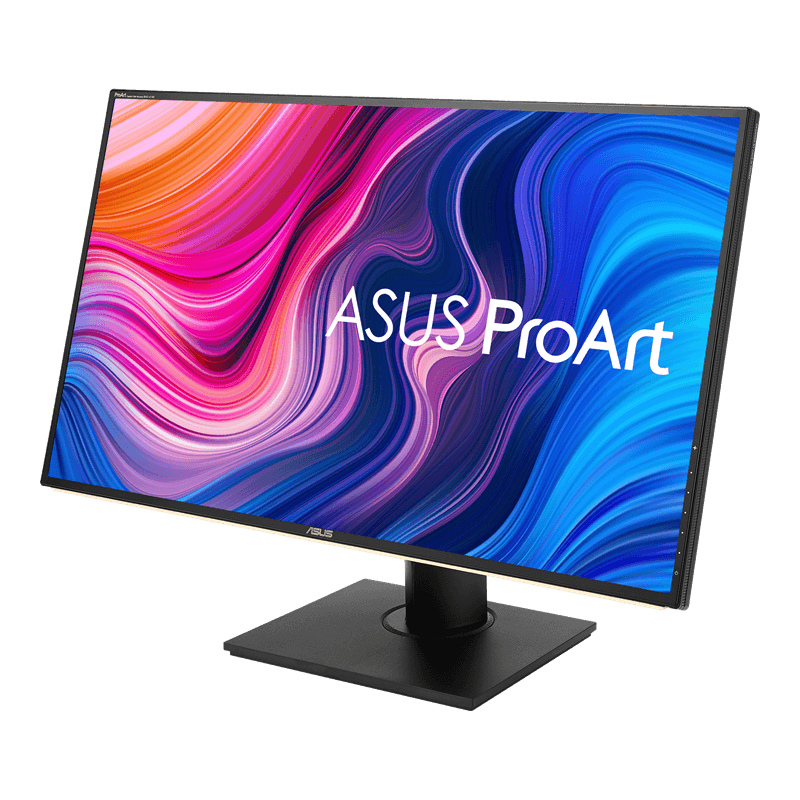
- Color Gamut: 100% sRGB, 100% AdobeRGB
- Panel Type: Mini-LED
- Screen Size / Resolution: 32 inches / 3840 x 2160
- Connectivity: USB Type-C, DisplayPort, HDMI
- Bonus Features: X-Rite hardware calibration device, USB hub
While this monitor is still a huge investment, it provides a much better balance of price vs. performance than you get from the more expensive Eizo CS2740. The high price mostly comes from the mini-LED backlight system, which displays beautifully dark blacks and excellent contrast while still maintaining perfect coverage of the sRGB and AdobeRGB colorspaces that are most popular with Photoshop users.
This monitor also ships with a hardware calibration device provided by X-Rite, which is a reputable name in the color correction industry.
Some people may find that the 32-inch screen size is a bit overwhelming, and even at 4K resolution, the added size causes a reduction in pixel density compared to a 27-inch 4K monitor, but for most common working distances, you won’t be able to spot the density difference unless you really look.
The TLDR Summary: ASUS ProArt PA329C is the best choice for those with an unlimited budget who want a gigantic but gorgeous editing monitor.
Best 27” Monitor for Photoshop Editing: ViewSonic VP2786-4K
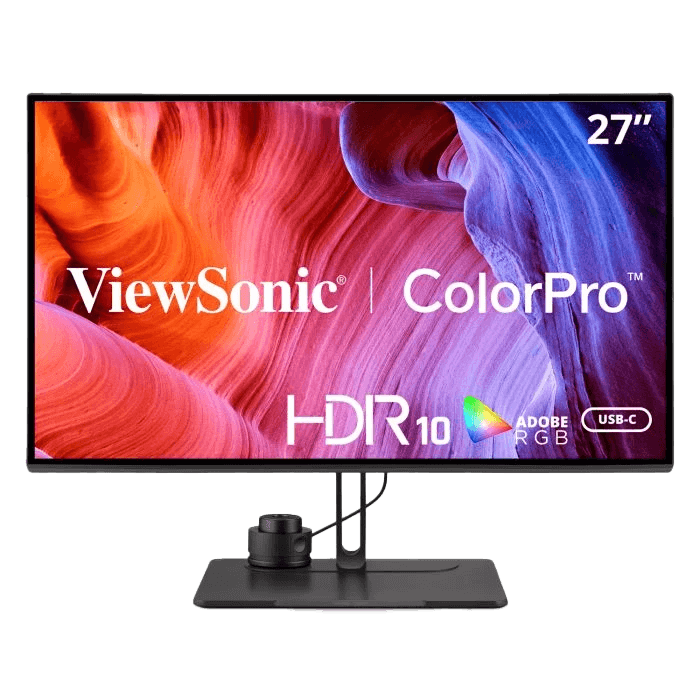
- Color Gamut: 100% sRGB, 100% AdobeRGB
- Panel Type: IPS
- Screen Size / Resolution: 27 inches / 3840 x 2160
- Connectivity: USB Type-C, DisplayPort, HDMI
- Bonus Features: Built-in color calibrator, detachable monitor hood, USB hub
This monitor is the one that I recommend as the best choice for most Photoshop users since it checks all of the important boxes, provides a full range of bonus features, and still manages to be reasonably affordable when compared to the other high-end monitors on this list.
The combination of 27-inch screen size and 4K resolution gives the highest pixel density of any of the monitors in this list, and the IPS panel provides decent contrast and viewing angles. When you add in full support for the sRGB color space used in digital imagery and full coverage of the AdobeRGB color space used in high-end photography workflows, you get a capable monitor that doesn’t completely dominate your workspace the way a 32” screen can.
ViewSonic has also included a built-in hardware calibration device that keeps your monitor looking its best, a magnetically-detachable monitor hood for minimizing screen glare, and a USB hub to connect all your devices easily.
Even though I mentioned that this monitor is affordable compared to some of the other options, it’s still an expensive purchase, so value-minded Photoshop editors who only work on digital projects may prefer to save money on the budget pick that’s next on the list.
The TLDR Summary: ViewSonic VP2786-4K is the best balance between screen size and resolution while still keeping perfect color accuracy for digital and print-based workflows.
Best Budget Monitor for Photoshop Editing: Asus ProArt Display PA278CV
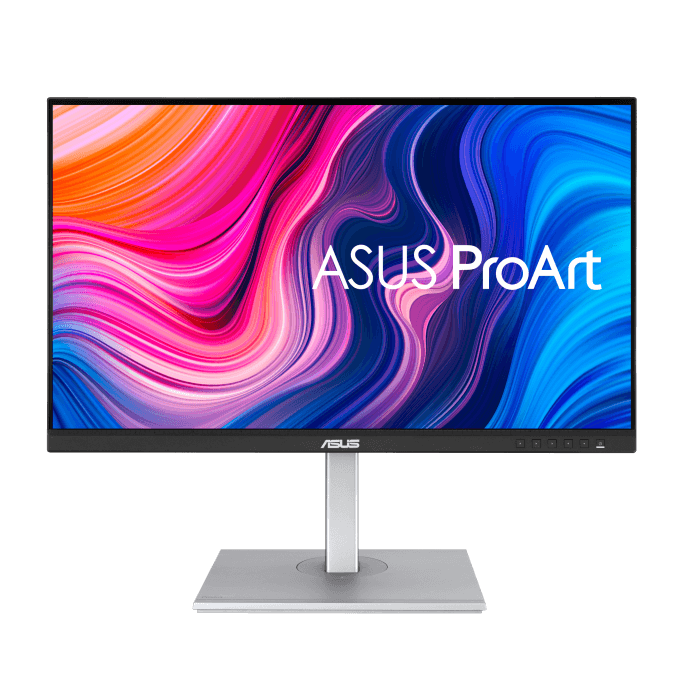
- Color Gamut: 100% sRGB, 79% AdobeRGB
- Panel Type: IPS
- Screen Size / Resolution: 27 inches / 2560 x 1440
- Connectivity: USB Type-C, DisplayPort, HDMI
- Bonus Features: USB hub, built-in speakers, 90-degree rotation
If you’re put off by the high prices found in the more high-end monitors on this list, the PA278CV will be a welcome relief. It doesn’t offer the same degree of image quality that you find in the other monitors, but it still has a bright 27-inch screen that covers the entire sRGB colorspace used in most digital Photoshop work.
Unfortunately, this also means that it’s not well-suited for print work or high-end photography, but it’s great for web content, graphic design, and other professional Photoshop projects.
In addition to a USB hub and built-in speakers, the PA278CV also includes the unique ability to rotate the display a full 90 degrees, which allows you to create your own custom monitor setup with ease.
The TLDR Summary: Asus ProArt Display PA278CV is the best choice for Photoshop users who focus entirely on web content and other screen-based imagery.
FAQs
Since your monitor is such a key part of a good Photoshop workflow, many users have questions about how to choose the best one. Here are a few of the most common questions that get asked, but if you’ve got another question that I didn’t answer below, let me know in the comments section at the end, and I’ll try to help out.
What is the best screen type for photo editing?
The most popular screen type for a photo editing monitor is an IPS panel with 4K / UHD resolution. OLED and mini-LED screens provide better contrasts, but they have their own drawbacks, like screen burn-in effects and high price points that have prevented them from dominating the market.
Is a curved or flat monitor better for photo editing?
A curved monitor is usually used for immersive PC gaming and not for detailed technical work. While you could use a curved monitor for photo editing, a flat monitor will provide you with a better reference point for making precision edits. If you ever need to align different image elements in your Photoshop work, you might run into trouble when using a curved monitor.
Is a 32” monitor too big for photo editing?
Not necessarily. A 32-inch monitor is not too big for photo editing as long as it has 4K / UHD resolution and as long as you can sit far enough away from it. If you’re sitting too close to a monitor of this size, you may be able to see the individual pixels too clearly, and not only that, you may have to move your entire head every time you look from one side of the screen to the other, which can get tiring after a full day of work.
A Final Word
Unless you’ve decided to go with one of the monitors featuring built-in calibration, you absolutely need to buy and use a color calibration device to make sure that you get the most out of your monitor. Almost like a musical instrument, even the best monitors can use some tuning every now and then to make sure they’re working at the peak of their abilities.
Enjoy your new monitor!
About Thomas Boldt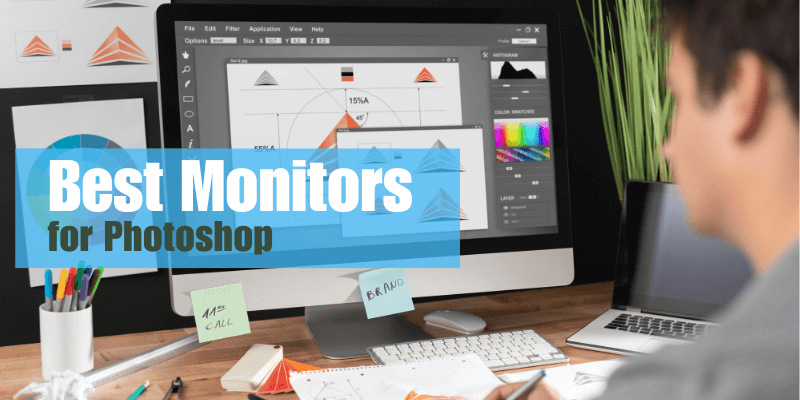
Manolis Kroussaniotakis
Hi,
Very interesting article. As a hobby photographer that has just ordered an Epson P900 A2 printer, I am now looking to upgrade my current MaxBook Pro (2015). At the low end would be an iMac 24, at the top end a Mac Studio/Studio display (but ouch!), or perhaps a 14″/16″ MBPro, ideally with a (Studio, but double ouch!) display.
I am hoping to start selling my prints and I work mostly in b&w, using only Mac Photos for light editing (cropping, contrast adjustment and cleaning up spots). Which monitors would you suggest for mostly b&w photos?
June
Hey Manolis, I would say that any options from this article can handle B&W photos pretty well!